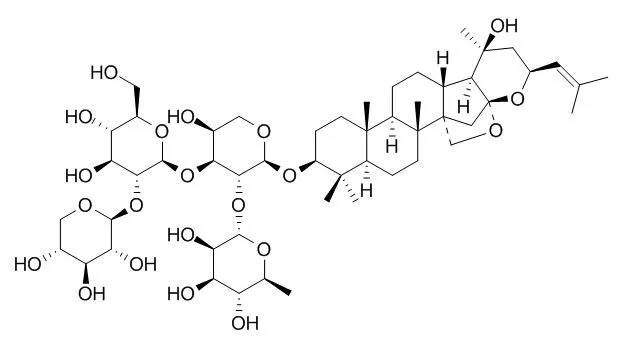| Description: |
Jujuboside B has antitumor activity and the underlying mechanism via induction of apoptosis and autophagy. It reduces vascular tension endothelium-dependently by increasing Ca2+Influx and activating endothelial nitric oxide synthase, it has pharmacological effects on improving endothelial dysfunction and treating vascular diseases. |
| Targets: |
Caspase | JNK | p38MAPK | Autophagy | NO | NOS | Calcium Channel |
| In vitro: |
| PLoS One. 2016 Feb 22;11(2):e0149386. | | Jujuboside B Reduces Vascular Tension by Increasing Ca2+ Influx and Activating Endothelial Nitric Oxide Synthase.[Pubmed: 26901291 ] | Jujuboside B has been reported to have protective effect on many cardiovascular diseases. However, the effects of Jujuboside B on vascular tension and endothelial function are unknown.
The present study investigated the effects of Jujuboside B on reducing vascular tension, protecting endothelial function and the potential mechanisms.
METHODS AND RESULTS:
The tension of isolated rat thoracic aorta ring was measured by Wire myograph system. The concentration of nitric oxide (NO) and the activity of endothelial nitric oxide synthase (eNOS) in human aortic endothelial cells (HAECs) were determined by Griess reagent method and enzyme-linked immune sorbent assay. The protein levels of eNOS and p-eNOS at Serine-1177 were determined by western blot analysis. Intracellular Ca2+ concentration in HAECs was measured by laser confocal imaging microscopy. Results showed that Jujuboside B reduced the tension of rat thoracic aorta rings with intact endothelium in a dose-dependent manner. L-NAME, KN93, EGTA, SKF96365, iberiotoxin and glibenclamide significantly attenuated Jujuboside B-induced vasodilation in endothelium-intact tissues. In contrast, indometacin and 4-DAMP had no such effects. Jujuboside B also promoted NO generation and increased eNOS activity, which were attenuated by L-NAME, EGTA and SKF96365. Moreover, Jujuboside B increased intracellular Ca2+ concentration dose-dependently, which was inhibited by EGTA and SKF96365. Besides, Jujuboside B induced a rapid Ca2+ influx instantaneously after depleting intracellular Ca2+ store, which was significantly inhibited by SKF96365.
CONCLUSIONS:
In conclusion, this study preliminarily confirmed that Jujuboside B reduced vascular tension endothelium-dependently. The underlying mechanisms involved that Jujuboside B increased extracellular Ca2+ influx through endothelial transient receptor potential cation (TRPC) channels, phosphorylated eNOS and promoted NO generation in vascular endothelial cells. In addition, Jujuboside B-induced vasodilation involved endothelium-dependent hyperpolarizaiton through endothelial potassium channels. Jujuboside B is a natural compound with new pharmacological effects on improving endothelial dysfunction and treating vascular diseases. |
|
| In vivo: |
| Phytother Res. 2013 Jun;27(6):829-34. | | Zizyphus jujuba and its active component jujuboside B inhibit platelet aggregation.[Pubmed: 22893618] | The seeds of Zizyphus jujuba (SZJ), a famous oriental traditional medicine, have been reported to exhibit diverse activities in biological systems including the cardiovascular system. However, little information is available on its antiplatelet activity. This study was undertaken to investigate the antiplatelet effects of the ethanolic extract of SZJ (ESZJ) and of its principal components jujuboside A and Jujuboside B.
METHODS AND RESULTS:
In the in vitro platelet aggregation study, ESZJ exhibited significant and concentration-dependent inhibitory effects on collagen-, thrombin-, and AA-induced platelet aggregation. In addition, ESZJ-treated mice showed significantly the prolongation of bleeding times and the protection against thromboembolic attack. A comparison of the effects of jujuboside A and Jujuboside B on platelet aggregation revealed that only Jujuboside B had potent inhibitory effects on collagen-, thrombin-, AA-, and ADP-induced aggregation. Jujuboside B also exhibited superior protection on thromboembolic model. Furthermore, Jujuboside B had a significant inhibitory effect on collagen-induced thromboxane A2 production in rat platelets.
CONCLUSIONS:
This study describes the antiplatelet effects of ESZJ and of its active component Jujuboside B, and its findings suggest that these agents be considered as components of preventive and therapeutic herbal drugs targeting cardiovascular diseases associated with platelet hyperaggregation. |
|






 Cell. 2018 Jan 11;172(1-2):249-261.e12. doi: 10.1016/j.cell.2017.12.019.IF=36.216(2019)
Cell. 2018 Jan 11;172(1-2):249-261.e12. doi: 10.1016/j.cell.2017.12.019.IF=36.216(2019) Cell Metab. 2020 Mar 3;31(3):534-548.e5. doi: 10.1016/j.cmet.2020.01.002.IF=22.415(2019)
Cell Metab. 2020 Mar 3;31(3):534-548.e5. doi: 10.1016/j.cmet.2020.01.002.IF=22.415(2019) Mol Cell. 2017 Nov 16;68(4):673-685.e6. doi: 10.1016/j.molcel.2017.10.022.IF=14.548(2019)
Mol Cell. 2017 Nov 16;68(4):673-685.e6. doi: 10.1016/j.molcel.2017.10.022.IF=14.548(2019)